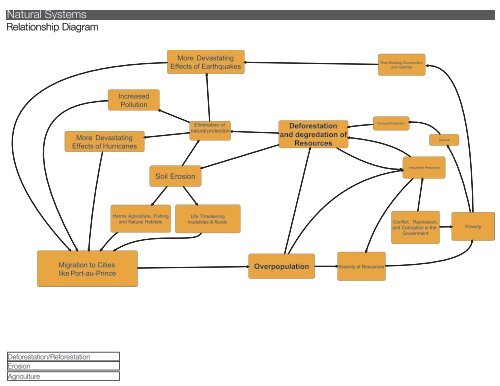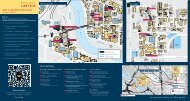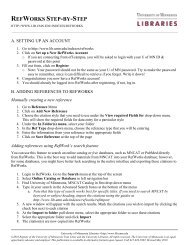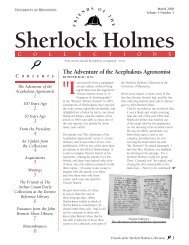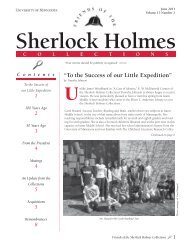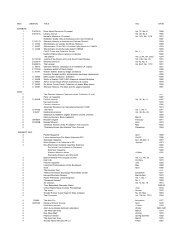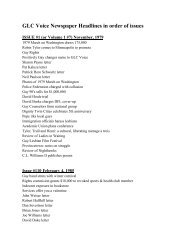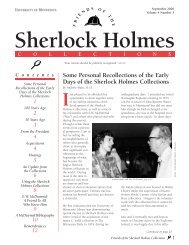Natural Systems
Natural Systems
Natural Systems
Create successful ePaper yourself
Turn your PDF publications into a flip-book with our unique Google optimized e-Paper software.
<strong>Natural</strong> <strong>Systems</strong><br />
Relationship Diagram<br />
More Devastating<br />
Effects of Earthquakes<br />
Poor Building Construction<br />
and materials<br />
Increased<br />
Pollution<br />
More Devastating<br />
Effects of Hurricanes<br />
Elimination of<br />
natural protection<br />
Deforestation<br />
and degredation of<br />
Resources<br />
Charcoal Production<br />
Survival<br />
Inequitable Resources<br />
Soil Erosion<br />
Harms Agriculture, Fishing<br />
and <strong>Natural</strong> Habitats<br />
Life Threatening<br />
mudslides & floods<br />
Conflict, Repression,<br />
and Corruption in the<br />
Government<br />
Poverty<br />
Migration to Cities<br />
like Port-au-Prince<br />
Overpopulation<br />
Scarcity of Resources<br />
Deforestation/Reforestation<br />
Erosion<br />
Agriculture
<strong>Natural</strong> <strong>Systems</strong><br />
Deforestation<br />
Border between Haiti and<br />
the Dominican Republic<br />
highlights the relative<br />
deforestation in Haiti.<br />
Deforestation/Reforestation<br />
Erosion<br />
Agriculture<br />
Source: National Geographic, 2010.
<strong>Natural</strong> <strong>Systems</strong><br />
Deforestation and Disasters<br />
Deforestation/Reforestation<br />
Erosion<br />
Agriculture<br />
Source: ReliefWeb, 2008.
<strong>Natural</strong> <strong>Systems</strong><br />
Alarming Statistics<br />
• Between 10 and 20 million trees are cut down each year<br />
• The annual reforestation rate is 0.7%<br />
• 53,300 trees per year are cut down for businesses to operate<br />
• Over 80% of the Haitian population has no access to electricity and over 90%<br />
uses wood-based charcoal for their daily cooking needs.<br />
• The Haitian government has not made the environment a priority.<br />
• The sale of charcoal is the main source of income for 9% fo the rural population<br />
of Haiti.<br />
Source: Fride, 2008; EarthTrends, 2003; Lewis & Coffey, 1985; Lea, 1996.<br />
Deforestation/Reforestation<br />
Erosion<br />
Agriculture
<strong>Natural</strong> <strong>Systems</strong><br />
TIMELINE<br />
Timeline of Deforestation in Haiti<br />
1400 1700 1800 1900 2000<br />
1492<br />
When Columbus reached<br />
the Caribbean island of<br />
Hispaniola, he wrote: “No<br />
human has ever beheld a<br />
more beautiful land; nowhere<br />
is nature so immeasurably<br />
lush, so<br />
green, so untouched.”<br />
Over 80% of the island<br />
was covered by lush vegetation.<br />
1700s<br />
Haiti is jewel of the<br />
French Empire, treasured<br />
for lush forests; however,<br />
logging begins as the<br />
french levelled thousands<br />
of hectares of<br />
brigin forest to plant<br />
sugar cane, cotton, and<br />
coffee. Wood was to used<br />
to operate brickworks,<br />
kilns, and tanneries. Trees<br />
were not replanted.<br />
1804<br />
Haiti gains independence<br />
from France, but is stil<br />
threatened with slavery.<br />
1825<br />
1915-1934<br />
Haiti reaches an agreement<br />
with France to pay<br />
them for their independence.<br />
Haitians were<br />
made to pay up to 80%<br />
of the country’s revenue<br />
($21 billion in current<br />
income). To pay the<br />
debt, Haitiains cut down<br />
forests, selling the tropical<br />
hard wood for the<br />
production of French furniture.<br />
Americans occupy Haiti<br />
and concentrate landownership<br />
with disregard<br />
to the land-holders who<br />
were evicted or became<br />
hired farm workers.<br />
“Before the American occupation,<br />
forest cover<br />
was 60% of the total surface<br />
in Haiti. By 1945<br />
forest cover had been<br />
reduced to 21%.<br />
1947<br />
1954<br />
1978<br />
The debt to France is<br />
paid off; however, forestry<br />
continues with the<br />
trees being made ito<br />
charcoal instead of furniture.<br />
Only 6.7% of the country<br />
is still forested (based on<br />
aerial photographs). Of<br />
the 6.7%, 36% had a<br />
dense canopy and 64%<br />
had an open canopy. An<br />
open canopy is a signifiier<br />
active tree cutting<br />
or burning.<br />
1978-1984<br />
Estimated that only 8-9%<br />
of the land remained<br />
under forest<br />
Forest area decreased<br />
from 4 to 13.6%.<br />
1990-2000<br />
1991-1994<br />
Forest reduction of 53%,<br />
compared with an average<br />
loss of 11% and 2%<br />
for Central America/<br />
Caribbean and the world,<br />
respectively.<br />
Deforestation in Haiti accelerated<br />
during the embargo<br />
imposed by the<br />
UN. Kerosene and petrol<br />
were among the products<br />
affected by the economic<br />
blockade. People<br />
had to cut trees for cooking<br />
and lighting needs.<br />
2010<br />
Due to extensive deforestation,<br />
only 1.5 to 2% of<br />
the forest coverage remains<br />
in Haiti.<br />
2015<br />
Estimated that only river<br />
basins in the extreme<br />
southest will have remaining<br />
forest cover.<br />
Year River Basin will be Completely Deforested<br />
Prior to 1985<br />
1990<br />
2000<br />
2010<br />
Forest parcels over 50 km in 1978<br />
Source: Fride, 2008; EarthTrends, 2003; Lewis & Coffey, 1985; Lea, 1996.<br />
Drawn by: Baudler, 2011.<br />
Deforestation/Reforestation<br />
Erosion<br />
Agriculture
<strong>Natural</strong> <strong>Systems</strong><br />
Vegetation and Land Use: 1970<br />
Deforestation/Reforestation<br />
Erosion<br />
Agriculture
<strong>Natural</strong> <strong>Systems</strong><br />
Forest Cover: 2004<br />
Deforestation/Reforestation<br />
Erosion<br />
Agriculture
<strong>Natural</strong> <strong>Systems</strong><br />
Land Cover: 2004<br />
Deforestation/Reforestation<br />
Erosion<br />
Agriculture
<strong>Natural</strong> <strong>Systems</strong><br />
Poverty<br />
Haiti Forest Cover: 2011 Haiti Energy Source: 2011<br />
Forested Land: 2%<br />
Renewable: 1%<br />
Oil: 23%<br />
Poverty causes many Haitians to seek income<br />
from natural resources. The sale of charcoal is<br />
the main source of income for 9% of the rural<br />
population. The charcoal comes from cutting<br />
trees, which accounts for the vast majority of<br />
the biomass used as an energy source by Haiti.<br />
Rural people must be empowered to find alternative<br />
sources of income.<br />
Unforested Land: 98%<br />
Biomass: 76%<br />
Source: UN World Food Programme<br />
Deforestation/Reforestation<br />
Erosion<br />
Agriculture
<strong>Natural</strong> <strong>Systems</strong><br />
Charcoal Production Areas in Haiti: 1980 to 1900<br />
Charcoal Production Areas in Haiti<br />
Increase in coal production from 1980 to 1990<br />
Source: UNDP Source: Johnson, 2007.<br />
Deforestation/Reforestation<br />
Erosion<br />
Agriculture<br />
1980<br />
1990<br />
ì The use of biomass is<br />
the biggest source of<br />
energy for Haiti. The charcoal<br />
and fuelwood industries<br />
are very important to<br />
the peopleís livelihood, but<br />
the practice is not sustainable.<br />
In the mean time, fuelwood<br />
meets 70% of<br />
energy needs. The emergence<br />
of an energy industry<br />
began in the 1940s and<br />
50ís in Haiti, so itis a relatively<br />
recent phenomenom.<br />
The use of the forests has<br />
spread in a matter of ten<br />
years.î Charcoal production<br />
rapidly spread between the<br />
years of 1980 to 1990. ì The<br />
increase in the fuel industry<br />
has exacerbated an already<br />
fragile environment.<br />
Crucial watersheds are destroyed<br />
leaving the land<br />
naked to destruction by<br />
storms which are becoming<br />
stronger every year.î
<strong>Natural</strong> <strong>Systems</strong><br />
<strong>Natural</strong> Disaster Casualties & Deforestation<br />
Deforestation/Reforestation<br />
Erosion<br />
Agriculture
<strong>Natural</strong> <strong>Systems</strong><br />
Wasteland - Deforestation in Haiti<br />
Jonathan Auch documents deforestation and charcoal production in Haiti through a series of powerful black and white images. Mr. Auch writes: “Once a<br />
lush island covered in trees Haiti is now 98 percent deforested. Twenty million trees are felled each year to meet the demand for the island’s primary fuel<br />
source; charcoal…. Haiti is quickly reaching an irrecoverable state where the majority of the island will succumb to desertification and become inhabitable.”<br />
Source: Auch, 2011<br />
View of patchwork landscape. 10 to 20 million trees are chopped down<br />
every year.<br />
Hillside scarred from years of deforestation due to charcoal production and<br />
logging. Only 1.5 to 2% of Haiti’s land remains forest.<br />
Deforestation/Reforestation<br />
Erosion<br />
Agriculture
<strong>Natural</strong> <strong>Systems</strong><br />
Wasteland - Deforestation in Haiti<br />
As the mountains are cleared, they are often coverted for mining. Silt is<br />
washed into the ocean from heavy rain, impacting fish and other wildlife.<br />
A rare old growth tree is cut down to be turned into charcoal.<br />
Deforestation/Reforestation<br />
Erosion<br />
Agriculture
<strong>Natural</strong> <strong>Systems</strong><br />
Wasteland - Deforestation in Haiti<br />
Farmers cut and stack wood into piles. They are then burned into charcoal<br />
where they will cure for two weeks.<br />
Charcoal farmer checking his charcoal. “This man was once a rice farmer<br />
but because of cheap imported American rice he was forced to start producing<br />
charcoal to support his family.”<br />
Deforestation/Reforestation<br />
Erosion<br />
Agriculture
<strong>Natural</strong> <strong>Systems</strong><br />
Wasteland - Deforestation in Haiti<br />
Charcoal market in Port-au-Prince.<br />
A charcoal market worker, known as a charbonniere. “The workers at the<br />
market spend 12 hours a day in the blistering sun on their hands and knees<br />
sorting charcoal into various sizes.”<br />
Deforestation/Reforestation<br />
Erosion<br />
Agriculture
<strong>Natural</strong> <strong>Systems</strong><br />
Deforestation- Charcoal in Haiti<br />
“The coastal charcoal market in the town of Arcahaie. Charcoal is sorted and<br />
loaded onto trucks for distribution, each bag weighs about 60lbs. Haiti uses<br />
approximetely 720,000 metric tons of charcoal annually.”<br />
“A charbonnière worker. The workers at the market spend 12 hours a day in<br />
the blistering sun on their hands and knees sorting charcoal.”<br />
Deforestation/Reforestation<br />
Erosion<br />
Agriculture
<strong>Natural</strong> <strong>Systems</strong><br />
Wasteland - Deforestation in Haiti<br />
“The ‘charbonnière’ make deliveries in Port-au-Prince from the market in Les<br />
Arcahaie. Charcoal is used for 76 percent of Haiti’s energy needs and must<br />
be delivered daily to meet demand.”<br />
“Workers take a rare break from loading charcoal into trucks at the market.”<br />
Deforestation/Reforestation<br />
Erosion<br />
Agriculture
<strong>Natural</strong> <strong>Systems</strong><br />
Reforestation Case Study #1<br />
Haiti Timber Re-Introduction Project (HTRIP):<br />
• is a community-based forestry in Haiti - began from a partnership between Hospital<br />
Albert Schweitzer haiti, interested members of the American forest industry, and other<br />
private donors.<br />
• began in 2006 to enable Haitians to re-create productive forests to improve their environment<br />
and health.<br />
• assists Haitians in growing commercially valuable timber tree species on marginal<br />
hillside lands<br />
• provides the trees and technical expertise while the farmer provides the land and<br />
labor (i.e., land in exchange for seedlings)<br />
• In 2006, over 1,300 trees were planted, with the participation of more than 175 Haitians<br />
• project is located in the mid-to-upper Artibonite Valley, an area with 40 inches of rain<br />
per year, with a dry period from November to March. The soils are very eroded and<br />
calcareous due to their limestone parent material.<br />
• livestock has been a significant challenge to reforestation, as the animals are rarely<br />
kept in enclosures<br />
• chose to begin reforestation with hard, fast-growing tree species: one native species<br />
(Cedrela odorata, Spanish Cedar), one naturalized species (Eucalyptus camadulensis),<br />
and one species that had not been previously introduced to Haiti (Paulownia sp.,<br />
Empress Tree). Paulownia is a fast-growing commercial species which re-sprouts<br />
after harvesting for up to 8 generations.One citrus tree and one nitrogen-fixing tree<br />
(Enterlobium cyclocarpum and Lysiloma sabicu) were also planted for every three<br />
timber trees.<br />
• word about the project is spread to communities at churches and meeting within a<br />
9.3 mile radius of Deschapelles.<br />
• there has been an average mortility rate of 27%<br />
• once the trees begin to mature (5-7 yrs.), the understory will become shaded, requiring<br />
a change in crop type. HTRIP will assist transition to coffee, chocolate, animal<br />
forage...<br />
Source: Sprenkle, 2007; Sprenkle, 2011<br />
Deforestation/Reforestation<br />
Erosion<br />
Agriculture<br />
HTRIP staff meets with community members at a<br />
future planting site.<br />
Volunteers digging a row of holes just below a contour<br />
canal.
<strong>Natural</strong> <strong>Systems</strong><br />
Reforestation Case Study #2 & #3<br />
Dominican Republic plans to reforest border with Haiti<br />
• DR plans to reforest its border with Haiti - first step is to plant 5 million seedlings<br />
• In the first stage, seedlings wiil be planted in nurseries, consisting of pine (3.2 million);<br />
mahogany (500,000); mango (200,000); oak, San Domigo boxwood, and black olive<br />
(250,000 each); and tamarind and guayacan (150,000 each).<br />
• work is expected to cost 35 million pesos (approx. US $980,000). On June 15, 2010,<br />
the DR’s Environment and <strong>Natural</strong> Resources Ministry signed an agreement with the<br />
Border Development Agency to go ahead with the project.<br />
• The goal is to restore land at risk from antural disasters in the Haitian border area and<br />
provide jobs.<br />
Source: InfoSur Hoy, 2011.<br />
Large reforestation Project: AFKB in Bayone<br />
• AFKB is an organization with 155 members<br />
• goal of producing 120,000 seedlings - fruit and forest trees - over two years that will<br />
permit the reforestation of 2 Vesan valleys in Haiti<br />
• funded by the Lambi Fund, which will also provide training on agro forestation techniques,<br />
tools and the equipment to buil 6 tree nurseries.<br />
Source: Lambi Fund, 2011.<br />
Employees of the Dominican Republic planting seedlings<br />
to reforest the border with Haiti.<br />
Deforestation/Reforestation<br />
Erosion<br />
Agriculture<br />
Large reforestation project in Bayone, Haiti.
<strong>Natural</strong> <strong>Systems</strong><br />
Haiti : Agriculture<br />
Social<br />
Income<br />
Cultivation and<br />
commercialization<br />
of<br />
traditional<br />
foods<br />
Marketing<br />
Trade<br />
Health<br />
Gender Tradition Social<br />
Culture<br />
Agriculture<br />
Valuation of<br />
environmental<br />
services<br />
Recognition of<br />
traditional and<br />
diversified land<br />
use Soils<br />
Water<br />
Climate<br />
Biodiversity<br />
Social<br />
“There is wide agreement that reconstruction will have to<br />
focus substantially on agriculture. The majority of<br />
Haitians live in rural areas and depend on agricultural<br />
activities for their livelihoods.”<br />
– Marc Cohen : Oxfam.org<br />
“When we live in these conditions, we are ready to accept<br />
everything that is offered to us. But it is better to be given<br />
things that are produced locally.”<br />
- Monrocher Antoine: Oxfam.org<br />
Economic<br />
If Haiti is going to be built back better then the international<br />
community needs to generously support the Haitian<br />
government’s agricultural investment plan.”<br />
- Philippe Mathieu : Oxfam.org<br />
Economic<br />
Environmental<br />
Environmental<br />
The combination of deforestation and soil nutrient mining<br />
due to low fertiliser usage has devastated the fertility of<br />
Haiti’s agricultural land. The loss of forest cover contributes<br />
to a topsoil erosion rate of 3 per cent per year.<br />
- Marc Cohen : Oxfam.org<br />
Deforestation/Reforestation<br />
Erosion<br />
Agriculture<br />
Diagram adapted from: International Assessment of Agricultural Science and Technology for Development (IAASTD) Report.<br />
http://qewnet.ning.com/forum/topics/mary-gilbert-and-others-report
<strong>Natural</strong> <strong>Systems</strong><br />
Agriculture : Social : History<br />
Haitian Identity : Relationship between Land and Liberty<br />
“Haiti set an example for the world as a pioneer<br />
nation, where a whole people rose from<br />
slavery to national freedom. Attention<br />
must be paid to the deep cultural<br />
importance of land in this struggle.”<br />
“The stability and security that<br />
come from the garden allow individuals<br />
to accept or refuse work,<br />
alleviating some of the damger of<br />
exploitation. Lakou is an ethical<br />
expression of free workers who are<br />
masters of their time and bodies.<br />
Deforestation/Reforestation<br />
Erosion<br />
“Lakou is community space composed of houses<br />
populated by several generations of the same<br />
family...The Garden of<br />
the lakou is the basic unit of the Haitian agricultural<br />
world.”<br />
“A family cultivates the necessary foods for consumption<br />
by working together, and seasonal harvests<br />
from the garden allow the family not to be<br />
entirely dependent on outside resources.”<br />
Agriculture<br />
The dream of every<br />
Haitian is to have a<br />
piece of land, and<br />
owning land is linked<br />
to the very idea of<br />
being Haitian because<br />
the land is a symbol of<br />
freedom.”<br />
New Haitian Villages, Steven Holl Architects; Guy Nordenson & Associates; Matthias Schuler, Transolar; Jean Henock<br />
Beauchamps& Araby Smyth. Pamphlet Architecture: 31. Princeton Architectural Press. New York. 2010
<strong>Natural</strong> <strong>Systems</strong><br />
Agriculture : Social : Current<br />
Gender Roles- Women in Agriculture<br />
“In rural areas, men and women played complementary roles. Men were primarily responsible for<br />
farming and, especially, for heavy work, such as tilling. Women, however, often assisted with tasks<br />
such as weeding and harvesting. Women were responsible for selling agricultural produce. In<br />
general, Haitian women participated in the labor force to a much greater extent than did women<br />
in other Latin American countries. Haiti's culture valued women's economic contribution to the<br />
farm in that all income generated through agricultural production belonged to both husband and<br />
wife. Many women also acquired sufficient capital to become full-time market traders, and they<br />
were thus economically independent. The income that they earned from nonfarm business activities<br />
was recognized as their own; they were not required to share it with their husbands.” -Haggerty<br />
http://www.jeansenatfleury.com/wpcontent/uploads/2010/10/Brevil-Merdenie.png;<br />
[accessed Feb. 2011]<br />
Heath- Impact of Cholera on Agricultural Sector<br />
Hurricane Tomas caused flooding and subsequently expanded outbreaks of cholera. “Fears of the<br />
epidemic are causing a rice shortage, as farmers avoid harvesting in the north-west due to fears<br />
that canals and rivers, which irrigate the crops, may be infected...consumers are also avoiding<br />
products from cholera affected regions causing more hardships.”<br />
ABC Rural. Choleral Threatens Haitian Agriculture; [accessed Feb. 2011]<br />
Wealth disparities<br />
80% of the population is living in poverty, like Jealene [the farmer from the economic case strudy]<br />
most people live on less than $2/ day.<br />
“The wealth gap between the impoverisvhed Creole speaking black majority and the French<br />
speaking mulattos, 1% of whom own nearly half of the country’s wealth, remains unaddressed.”<br />
- Schifferes<br />
Deforestation/Reforestation<br />
Erosion<br />
Agriculture<br />
http://www.wunrn.com/news/2008/12_08/12_22_08/122208_haiti.htm<br />
[accessed Feb. 2011<br />
Schifferes, Steve. Haiti: An economic Basket-Case; BBC News Online Economics Report. [Updated: March<br />
2004] [Accessed: Jan 2010]
<strong>Natural</strong> <strong>Systems</strong><br />
Agriculture : Social : Current Facts<br />
Total population (millions): 9.2<br />
Life expectancy at birth: 52<br />
Urban population: 38%<br />
Farming population (incl. forestry and fishing) (millions): 5.07<br />
Undernourished population (millions): 5.3<br />
Proportion of undernourished/total population:<br />
58%<br />
Per capita daily calorie intake (kcal/day): 1 840<br />
Per capita daily protein intake (%/ kcal): 9%<br />
Child malnutrition, underweight: 22%<br />
Child malnutrition, stunting: 24%<br />
Deforestation/Reforestation<br />
Erosion<br />
Agriculture<br />
http://canteensforthechildrenofhaiti.org.p8.hostingprod.com/<br />
http://www.fao.org/countries/55528/en/hti/
<strong>Natural</strong> <strong>Systems</strong><br />
Agriculture : Social : Case Study : LONDON_2045<br />
“New Space for Old Space: An Urban<br />
Vision,” presents a retrospective from the year<br />
2045 imagining the development of CPUL’s in<br />
London, England. Though glamorized it provides<br />
a plausible account for what the city of<br />
London might look like and how it might function<br />
in 35 years if there were immediate development<br />
of CPUL’s.<br />
The account imagines what the life of a<br />
London farmer would be like day to day; harvesting<br />
and selling produce from localized<br />
kiosks, and enjoying a relaxed evening. It hypothesizes<br />
that by 2045 London will have<br />
stopped growing, and that the success of<br />
CPULs will “have grown alongside three main<br />
urban prerequisites: population stability, successful<br />
public transport and borough balance.”<br />
http://www.foodnut.com/431/borough-market-london-uk/<br />
http://golondon.about.com/od/thingstodoinlondon/ig/St-Jamess-Park-Photos/<br />
View-of-London-Eye.htm<br />
Deforestation/Reforestation<br />
Erosion<br />
Agriculture<br />
“New Space for Old Space: An Urban Vision.” Katrin Bohn and Andre Viljoen: In: CPULs Continuous Productive Urban Landscapes:<br />
Designing Urban Agriculture for Sustainable Cities; Pgs: 4-16 Elsevier: Architectural Press; Oxford. Editors: Viljoen,
<strong>Natural</strong> <strong>Systems</strong><br />
Agriculture : Economics : Historic + Current Conditions<br />
HISTORY<br />
1950s Agriculture =<br />
80 % of Labor Force<br />
and<br />
50% Gross Domestic Product<br />
and<br />
90% of Exports<br />
1990s Agriculture =<br />
66 % of Labor Force<br />
and<br />
35% Gross Domestic Product<br />
and<br />
24% of Exports<br />
5% or National Budget =<br />
Ministry of Agriculture<br />
CURRENT<br />
66% of Haitians Depend upon<br />
small scale subsistence farming<br />
yet it only accounts for:<br />
23% of Gross Domestic Product<br />
Factors contributing to the decline of Haitis<br />
agriculture include low levels of agricultural<br />
technology, migration out of rural areas, insecure<br />
land ownership, a lack of capital investment,<br />
high commodity taxes, the low productivity<br />
of undernourished farmers, animal and<br />
plant diseases, and inadequate infrastructure.<br />
Low governmental investment in agricultural<br />
activities<br />
Cash Crops:<br />
Essential Oils<br />
Cocoa Beans<br />
Mangoes<br />
Coffee<br />
Food Crops:<br />
Rice<br />
Beans<br />
Avocados<br />
Pineapples<br />
Deforestation/Reforestation<br />
Erosion<br />
Agriculture<br />
CIA World Factbook; https://www.cia.gov/library/publications/the-world-factbook/geos/ha.html. Updated: Jan 2011 [Accessed: Jan 2011]<br />
Haiti. Richard A. Ha ggerty, ed. Haiti: A Country Study. Washington: GPO for the Library of Congress, 1989. http://countrystudies.us/haiti/<br />
Agriculture, [Accessed: Jan 2011]<br />
http://earthtrends.wri.org/pdf_library/country_profiles/agr_cou_332.pdf [Accessed: Jan 2011]
<strong>Natural</strong> <strong>Systems</strong><br />
Agriculture : Economics : Current : Crops<br />
Deforestation/Reforestation<br />
Erosion<br />
Agriculture<br />
Food and Agriculture Organization of the United Nations http://faostat.fao.org/desktopdefault.aspx?pageid=342&lang=en&country=93
<strong>Natural</strong> <strong>Systems</strong><br />
Agriculture : Economics : Current : Crops<br />
Deforestation/Reforestation<br />
Erosion<br />
Agriculture<br />
Food and Agriculture Organization of the United Nations http://faostat.fao.org/desktopdefault.aspx?pageid=342&lang=en&country=93
<strong>Natural</strong> <strong>Systems</strong><br />
Agriculture : Economics : Current : Production v. Exports v. Imports<br />
1000 MT<br />
1000 MT<br />
Sugar<br />
200<br />
150<br />
100<br />
50<br />
0<br />
1960 1970 1980 1990 2000 2010<br />
Rice<br />
350<br />
300<br />
250<br />
200<br />
150<br />
100<br />
50<br />
0<br />
1960 1970 1980 1990 2000 2010<br />
Coffee<br />
700<br />
Producon<br />
Exports<br />
Imports<br />
Producon<br />
Exports<br />
Imports<br />
1000 MT<br />
1000 MT<br />
Corn<br />
350<br />
300<br />
250<br />
200<br />
150<br />
100<br />
50<br />
0<br />
1960 1970 1980 1990 2000 2010<br />
Wheat<br />
250<br />
200<br />
150<br />
100<br />
50<br />
0<br />
1960 1970 1980 1990 2000 2010<br />
Cotton<br />
12<br />
Producon<br />
Exports<br />
Imports<br />
Producon<br />
Exports<br />
Imports<br />
Note:<br />
Production has decreased<br />
and imports have increased<br />
so dramatically in Sugar<br />
and Rice due to trade liberaliztion.<br />
In 1986 the International<br />
Monetary Fund (IMF)<br />
loaned Haiti 24 million<br />
dollars only if they lowered<br />
tariff protections for their<br />
Haitian rice and other agricultural<br />
products to open<br />
up the country’s markets to<br />
competition from outside<br />
countries.<br />
By 1988, so much American<br />
rice had invaded the country<br />
that it became unprofitable<br />
for many Haitian farmers<br />
to continue planting.<br />
1000 60 KG Bags<br />
600<br />
500<br />
400<br />
300<br />
200<br />
100<br />
Producon<br />
Exports<br />
Imports<br />
1000 480lb Bales<br />
10<br />
8<br />
6<br />
4<br />
2<br />
Producon<br />
Exports<br />
Imports<br />
This is compounded by the<br />
population explosion from<br />
5 million in 1990 to 9 million<br />
today<br />
0<br />
1960 1970 1980 1990 2000 2010<br />
0<br />
1960 1970 1980 1990 2000 2010<br />
Deforestation/Reforestation<br />
Erosion<br />
Agriculture<br />
Schifferes, Steve. Haiti: An economic Basket-Case; BBC News Online Economics Report. [Updated: March 2004] [Accessed: Jan 2011]<br />
Stabroek Staff. Trade Liberalization Killed Haiti’s Rice Industry. Jan 2010. www.stabroeknews.com. [Accessed: Jan 2011]<br />
www.indexmundi.com/agriculture/?country=ht [Accessed: Jan 2011]
<strong>Natural</strong> <strong>Systems</strong><br />
Agriculture : Economics : Future<br />
Haiti National Agricultural Investment Plan, May 2010<br />
Priority sub-sectors and investment requirements,<br />
Donor Pledges Towards<br />
Haiti’s Agricultural<br />
Reconstruction<br />
Infrastructure<br />
Watershed development<br />
Reforestation<br />
Irrigation<br />
361 MILLION<br />
Inter-<br />
American<br />
Development<br />
Bank<br />
(IDB)<br />
200 MILLION<br />
Production and value chain development<br />
Livestock<br />
Aquaculture and fishing<br />
Crops<br />
Input provision<br />
Credit<br />
Value chain development<br />
Urban and peri-urban agriculture<br />
Local purchase of food aid<br />
346 MILLION<br />
United States<br />
Global<br />
Agriculture<br />
and Food<br />
Security<br />
Program<br />
(GAFSP)<br />
202 MILLION<br />
35 MILLION<br />
Agricultural services and institutions<br />
Extension<br />
Land access and tenure security<br />
Research, training, plant health, institutional support<br />
62 MILLION<br />
International<br />
Fund for<br />
Agricultural<br />
Development<br />
(IFAD)<br />
21 MILLION<br />
France<br />
7 MILLION<br />
TOTAL<br />
769 MILLION<br />
TOTAL<br />
465 MILLION<br />
Deforestation/Reforestation<br />
Erosion<br />
Agriculture<br />
Oxfam.org (accessed Jan. 2011) with:<br />
MARNDR (2010), National Agricultural Investment Plan, Port-au-Prince: MARNDR and:<br />
OCHA (http://www.reliefweb.int, accessed 17 September 2010); US government
<strong>Natural</strong> <strong>Systems</strong><br />
Agriculture : Economics : Case Study : Haitian_Mangoes<br />
PLAYERS<br />
Jean Maurice Buteau<br />
- Business Man<br />
- “MANGO MAN”<br />
Jealene Jermus<br />
- FARMER<br />
Pierre Brunache<br />
- USAID: MarChE<br />
- NGO<br />
PROBLEM<br />
Consumers in New York and Miami want mangoes, but Jean Maurice can’t meet the demand.<br />
Haiti acutally grows enough Mangoes to meet demand<br />
Farmers pick Mangoes, but do not clean or store properly for pick up. This results in<br />
marks and bruises on Mangoes, cannot conceptualize 21st century Americans caring about this.<br />
IDEA<br />
Clean the fruit, and transport it in a plastic crate to a facility that is not exposed to the sun<br />
CONCEPT<br />
Involve NGO:<br />
EDUCATE: Provide intermediary to train farmers to use crates, teach them why they would<br />
want to use them, how to accommodate the needs of people living in the 21st century America.<br />
INFRASTRUCTURE: Cant just hand out crates to thousands of dispersed farmers, rather you need a<br />
central place with a simple structure. “Picture a carport, ¼ acre of land with a hose, farmers will bring their mangoes, learn<br />
how to pack the crates correctly, and how to wash the mangoes.”<br />
Deforestation/Reforestation<br />
Erosion<br />
Agriculture<br />
This American Life: Island Time- ACT ONE. 10,000 BRAINIACS Planet Money: National Public Radio News
<strong>Natural</strong> <strong>Systems</strong><br />
Agriculture : Economics : Case Study : Haitian_Mangoes<br />
STEP ONE:<br />
LAND<br />
Jean Maurice contacts someone who knows<br />
Jealene, and puts them in contact with eachother.<br />
Jealene is a Mango farmer with alot of land<br />
looking to possibly double her profits<br />
to $4/day. Jealene must convince over<br />
60 family members, who have claim to land<br />
to donate. After months<br />
of conversation the family agrees to donate.<br />
STEP TWO:<br />
BUILD?<br />
Mid 2008 Late 2008<br />
Jean Maurice contacts Pierre and MarChE<br />
to let them know that land has been<br />
donated and they can begin building<br />
the Mango Carport<br />
NGO [MarChE] tells Jean Maurice, “Great, we<br />
just need to see a copy of the deed..<br />
STEP THREE:<br />
THE DEED<br />
Early 2009<br />
Jealenes family has an ‘understanding’<br />
with original family who owned the land,<br />
but no one knows where to find<br />
original family or deed.<br />
Finally a brother remembers an uncle<br />
who kept papers and was currently<br />
in New York. He sent papers and<br />
deed arrives<br />
STEP FOUR:<br />
THE TRANSFER<br />
Transfer of land deed takes 100s of<br />
steps and 100s of dollars. Not in<br />
NGO’s budget; “DON’T CHANGE THE<br />
BUDGET. ”<br />
Sometimes things happen.. have to find<br />
money<br />
MarChE finds Money<br />
FINAL STEP:<br />
COOPERATIVE<br />
Mid 2009 DEC. 2009<br />
Deforestation/Reforestation<br />
Erosion<br />
Agriculture<br />
SUCCESS they get to the last step.<br />
December 29th, A year and a half after<br />
they began, farmers form cooperative,<br />
and bring document to<br />
Ministry of Social Affairs in Port Au<br />
Prince.<br />
DISASTER<br />
JAN. 2010<br />
EARTHQUAKE:<br />
START OVER?...<br />
2010...<br />
Document that recognizes them,<br />
was at ministry of social affairs, and<br />
this ministry has been “flattened like<br />
a pancake.”<br />
USAID cut funding of MarChE<br />
Mango season<br />
opens crate-less.<br />
This American Life: Island Time- ACT ONE. 10,000 BRAINIACS Planet Money: National Public Radio News
<strong>Natural</strong> <strong>Systems</strong><br />
Agriculture : Environment : Climate<br />
40<br />
35<br />
30<br />
25<br />
20<br />
15<br />
10<br />
5<br />
0<br />
Yearly Average Precipitation and Temperature<br />
Jan Feb Mar Apr May Jun Jul Aug Sep Oct Nov Dec<br />
Precipitation (cm)<br />
Average Temperature (C)<br />
http://www.climatetemp.info/haiti/<br />
Climate<br />
“Haiti has a generally hot and humid<br />
tropical climate. The north wind brings<br />
fog and drizzle, which interrupt Haiti's dry<br />
season from November to January. But during<br />
February through May, the weather is very wet.<br />
Northeast trade winds bring<br />
rains during the wet season.<br />
Rainfall is unevenly distributed.<br />
Heavier rainfall occurs in the southern<br />
peninsula and in the northern plains and<br />
mountains. Rainfall decreases from<br />
east to west across the northern<br />
peninsula. The eastern central region<br />
receives a moderate amount of precipitation,<br />
while the western coast from the northern<br />
peninsula to Port-au-Prince, the capital, is<br />
relatively dry”<br />
Deforestation/Reforestation<br />
Erosion<br />
Agriculture<br />
Richard A. Haggerty, ed. Haiti: A Country Study. Washington: GPO for the Library of Congress, 1989.
<strong>Natural</strong> <strong>Systems</strong><br />
Agriculture : Environment : Geography<br />
Geography<br />
Haiti is a country of only about 28,000<br />
square kilometers, about the size of the<br />
state of Maryland. It occupies the western third<br />
of the Caribbean island of Hispaniola<br />
The mainland of Haiti has three regions: the<br />
northern region, which includes the northern<br />
peninsula; the central<br />
region; and the southern region,<br />
which includes the southern peninsula. In<br />
addition, Haiti controls several nearby islands.<br />
http://www.intute.ac.uk/worldguide/html/905_map.html<br />
Numerous rivers and streams, which slow to a<br />
trickle during the dry season and which carry<br />
torrential flows during the wet season, cross<br />
Haiti's plains and mountainous areas. The<br />
largest drainage system in the<br />
country is that of the Artibonite<br />
River.<br />
Deforestation/Reforestation<br />
Erosion<br />
Agriculture<br />
Richard A. Haggerty, ed. Haiti: A Country Study. Washington: GPO for the Library of Congress, 1989.
<strong>Natural</strong> <strong>Systems</strong><br />
Agriculture : Environment : Land Use<br />
Land area (‘000 ha): 2 756<br />
Arable land (‘000 ha): 780<br />
Proportion of Arable Land : 28%<br />
Permanent crops (‘000 ha): 320<br />
Forest areas (‘000 ha): 105<br />
Irrigated land (‘000 ha): 92<br />
http://www.fao.org/countryprofiles/maps.asp?iso3=HTI&lang=en<br />
Share in total water use by<br />
* agriculture: 93.9%<br />
* industry: 1%<br />
* domestic use: 5.1%<br />
Deforestation/Reforestation<br />
Erosion<br />
Agriculture<br />
http://www.fao.org/countries/55528/en/hti/
<strong>Natural</strong> <strong>Systems</strong><br />
Agriculture : Environment : Average Precipitation and Crop Calendar<br />
http://www.fao.org/giews/countrybrief/country.jsp?code=HTI<br />
http://www.bestcountryreports.com/Precipitation_Map_Haiti.html<br />
Haiti’s growing season is year round<br />
There are 2 rainy seasons in Haiti: April-<br />
May and August-October<br />
Deforestation/Reforestation<br />
Erosion<br />
Agriculture<br />
http://www.southtravels.com/america/haiti/weather.html
<strong>Natural</strong> <strong>Systems</strong><br />
Agriculture : Environment : Erosion & Deforestation<br />
“The combination of widespread deforestation and the<br />
recent earthquake in Haiti could lead to more landslides in<br />
the already hard-hit country, scientists say (Haiti map).<br />
Many of Haiti's people, the poorest in the Americas,<br />
routinely cut down trees for fuel—either to burn "raw" or<br />
turn into charcoal.<br />
As a result, the destruction of Haiti's natural forests is almost<br />
total, making the Caribbean country one<br />
of the most deforested in the world.<br />
As Haiti's trees have disappeared, landslides have become a<br />
major concern, especially during the rainy season, and the<br />
destabilizing effects of an earthquake on soil only worsen<br />
the problem.<br />
Forest canopies serve as natural buffers against wind and<br />
rain, and the deep roots of trees help keep the granular soil<br />
from shifting.<br />
"If you remove the trees, you have no buffer. So the<br />
water"—and soil—"tends to very quickly move downhill,"<br />
said Mark Ashton, a professor at the Yale School of Forestry<br />
and Environmental Studies.” -National Geographic<br />
http://news.nationalgeographic.com/news/2010/01/100114-haiti-earthquake-landslides/<br />
The loss of topsoil is devastating to the<br />
practice of agriculture, as nutrients that have<br />
been built up over thousands of years and stored in the soil<br />
can be washed away in a matter of days or years.<br />
Deforestation/Reforestation<br />
Erosion<br />
Agriculture<br />
Than, Ker. “Haiti Earthquake, Deforestation Heighten Landside Risk.” National Geographic News Jan 14, 2010 [Accessed Jan 2011]<br />
http://news.nationalgeographic.com/news/2010/01/100114-haiti-earthquake-landslides/
<strong>Natural</strong> <strong>Systems</strong><br />
Agriculture : Environment : Case Study : Cuba_Urban Agriculture<br />
‘Urban Agriculture in Havana: Opportunities for the<br />
Future,’ “describes the innovative and comprehensive model<br />
supporting food production within the boundaries of its cities<br />
using a combination of top-down and bottom-up approaches.<br />
With the collapse of the eastern Europe block, and increased<br />
economic and trade sanctions by the United States, in the<br />
1990’s Cuba lost more than 75 percent of its import and export<br />
capacity and was forced to find new ways to supply food to its<br />
citizens.<br />
After 1990, reform was passed in Cuba called the National<br />
Alternative Agriculture Model (NAAM). Similar to Haiti’s current<br />
situation is that Cuba restructured its land property patterns<br />
from the large state-owned farms into smaller units with cooperative<br />
property. This dissemination of land came with support<br />
to many of the new farmers through advice, material support<br />
and encouragement in the management of agricultural<br />
activities, from the Ministry of Agriculture.<br />
There have been many benefits in Cuba, due to urban<br />
agriculture, in social, economic, and environmental dimensions,<br />
including food production and nutritional values, the creation<br />
of jobs, reduced food prices, and organic production methods.<br />
Though Cuba was largely forced to develop its urban agricultural<br />
practices out of necessity, it provides an interesting and<br />
unique case study into the how a small Caribbean Nation like<br />
Haiti might successfully develop agriculture within Port-au-<br />
Prince.<br />
http://www.urbanhabitat.org/node/4845<br />
http://www.treehugger.com/files/2009/05/urban-agriculture-in-cities.php<br />
Deforestation/Reforestation<br />
Erosion<br />
Agriculture<br />
“Urban Agriculture in Havana: Opportunities for the future.” Jorge Pena Diaz and Professor Phil Harris In: CPULs Continuous Productive Urban<br />
Landscapes: Designing Urban Agriculture for Sustainable Cities; Pgs: 136-145 Elsevier: Architectural Press; Oxford. Editors: Viljoen, Andre; Bohn,
<strong>Natural</strong> <strong>Systems</strong><br />
<strong>Natural</strong> Hazards<br />
Deforestation/Reforestation<br />
Erosion/<strong>Natural</strong> Disaster<br />
Agriculture<br />
http://www.reliefweb.int/rw/rwb.nsf/db900sid/MNIN-82YTA9?OpenDocument&query=haiti%20multi-hazard
<strong>Natural</strong> <strong>Systems</strong><br />
<strong>Natural</strong> Disaster<br />
Haiti is extremely susceptible to natural<br />
disasters due to many factors.<br />
– High Poverty levels<br />
– Inadaquate building code regulations<br />
and . enforcement<br />
– Loss of stable natural protection due to<br />
deforestation<br />
– Disruption of natural water sheds<br />
– Over population<br />
– Inadaquate disaster response plans<br />
Images: http://www.architectureweek.com/2010/0407/building_1-1.html<br />
Deforestation/Reforestation<br />
Erosion/<strong>Natural</strong> Disasters<br />
Agriculture
<strong>Natural</strong> <strong>Systems</strong><br />
<strong>Natural</strong> Disaster<br />
Deforestation/Reforestation<br />
Erosion/<strong>Natural</strong> Disaster<br />
Agriculture<br />
http://www.reliefweb.int/rw/rwb.nsf/db900sid/RKRR-8CDR8W?OpenDocument&query=haiti
<strong>Natural</strong> <strong>Systems</strong><br />
<strong>Natural</strong> Hazards<br />
The January 12th earthquake was compounded<br />
by other events, caused by, and<br />
occurring right after the earthquake.<br />
– The outbreak of cholera exacerbated,<br />
if not caused, by overcrowding<br />
and inadequate sanitary conditions in<br />
displacement camps, land and mud<br />
slides caused by the earthquake,<br />
tropical storms and hurricane Tomas,<br />
and flooding caused by the rainy<br />
season.<br />
http://www.hurriyetdailynews.com/n.php?n=haiti-cholera-death-toll-soars-as-election-nears-2010-11-15<br />
Deforestation/Reforestation<br />
Erosion/<strong>Natural</strong> Disaster<br />
Agriculture<br />
http://www.cdc.gov/haiticholera/update/
<strong>Natural</strong> <strong>Systems</strong><br />
Cholera<br />
http://haiti.humanitarianresponse.info/Portals/0/hti_cholera_cases_110127.pdf<br />
Deforestation/Reforestation<br />
Erosion/<strong>Natural</strong> Disaster<br />
Agriculture
<strong>Natural</strong> <strong>Systems</strong><br />
Erosion<br />
Images taken from Google Earth<br />
Deforestation/Reforestation<br />
Erosion/<strong>Natural</strong> Disaster<br />
Agriculture
<strong>Natural</strong> <strong>Systems</strong><br />
Disaster: Chile compared with Haiti<br />
• Severity of the Disaster was enhanced by<br />
proximity to large populated area.<br />
• When Compared to the February 27th<br />
earthquake in Chile which registered an<br />
8.8 on the Moment Magnitude Scale and<br />
officially killed 452, the Haiti 7.0 earthquake<br />
was far more catastrophic with an<br />
estimated 222,570 deaths..<br />
• Many factors are attributed this difference<br />
in severity.<br />
•<br />
According to USGS reports, compared to<br />
the Chile event, the Haiti earthquake was<br />
shallower, much closer to a large population<br />
center, and highly concentrated<br />
relative to its magnitude value.<br />
• Chile also has very strict seismic building<br />
codes.<br />
http://graphics8.nytimes.com/images/blogs/opinionator/arieff/infographicXL.jpg<br />
• “Shake maps” created using the Modified<br />
Mercalli Intensity Scale indicate that haiti<br />
had vastly more structures, occupied by<br />
as many more people, subjected to the<br />
highest levels of shaking<br />
http://www.architectureweek.com/2010/0407/building_1-1.html<br />
Deforestation/Reforestation<br />
Erosion/<strong>Natural</strong> Disaster<br />
Agriculture
<strong>Natural</strong> <strong>Systems</strong><br />
Disaster: Chile compared with Haiti<br />
Extreme example of concrete failure.<br />
The USGS/ EERI<br />
Advance Reconnaissance<br />
Team found<br />
that smooth steel<br />
with inadequately<br />
sized hooks was used<br />
in reinforcing the<br />
concrete of the Hotel<br />
Montana.<br />
http://www.architectureweek.com/cgibin/awimage?dir=2010/0407&article=building_1-2.html&image=14595_image_10.jpg<br />
http://www.architectureweek.com/cgibin/awimage?dir=2010/0407&article=building_1-3.html&image=14596_image_3.jpg<br />
Deforestation/Reforestation<br />
Erosion/<strong>Natural</strong> Disaster<br />
Agriculture
<strong>Natural</strong> <strong>Systems</strong><br />
Earthquakes<br />
Deforestation/Reforestation<br />
Erosion/<strong>Natural</strong> Disaster<br />
Agriculture<br />
http://www.reliefweb.int/rw/rwb.nsf/db900sid/JOPA-7ZNJWW?OpenDocument
<strong>Natural</strong> <strong>Systems</strong><br />
Earthquakes<br />
• Walter Mooney, a USGS<br />
earthquake expert who<br />
traveled to Haiti as part<br />
of the USGS/ EERI Ad -<br />
vance Reconnaissance<br />
Team says that “The<br />
future is not rosy. They<br />
have to be prepared for<br />
another event of equal<br />
magnitude” within the<br />
next 10 to 20 years, he<br />
says. “Historically, that’s<br />
what happens.”<br />
http://www.architectureweek.com/2010/0407/building_1-1.html<br />
http://www.nytimes.com/interactive/2010/01/18/world/americas/0118-haiti-assess-maps.html<br />
Diagram of the reactions of the 2010 earthquake along Haiti’s southern strike-slip fault<br />
near Port-au-Prince<br />
Deforestation/Reforestation<br />
Erosion/<strong>Natural</strong> Disaster<br />
Agriculture
<strong>Natural</strong> <strong>Systems</strong><br />
Port-a-Piment Watershed<br />
– The Port-a-Piment watershed faces a series<br />
of challenges common throughout Haiti,<br />
vulnerable populations, deteriorating<br />
ecosystems and decreasing yields with a<br />
high livelihood dependency on natural<br />
resource extraction.<br />
– Reports indicated that substantial temporary<br />
in-migration to Port-a-Piment since the<br />
earthquake has increased the population,<br />
exacerbated pressure on natural resources,<br />
and led to food insecurity.<br />
(http://www.haitiregeneration.org/piment_mvp)<br />
http://www.haitiregeneration.org/sites/default/files/HRI_ExecutiveSummary_v1-lowres.pdf<br />
Deforestation/Reforestation<br />
Erosion/<strong>Natural</strong> Disaster<br />
Agriculture<br />
http://www.haitiregeneration.org/sites/default/files/images/project%20area%20map.jpg
<strong>Natural</strong> <strong>Systems</strong><br />
Port-a-Piment Watershed<br />
Watersheds major challenges:<br />
– Extremely low yields for virtually all forms of agriculture<br />
– Unsustainable and environmentally destructive livestock<br />
production<br />
– Low agricultural diversity and minimal rotations and fallow<br />
and nutrient depleted soils<br />
– Destructive cultivation of hillside steep slope zones in the<br />
absence of anti-erosion structures and appropriate long-term<br />
vegetative cover, resulting in massive erosion and<br />
permanent productivity losses.<br />
– Unsustainable harvest of woody biomass, mainly for the<br />
charcoal market, resulting in deforestation and soil erosion<br />
– Problematic land tenure, which constrains efforts to invest in<br />
and sustainable production.<br />
http://www.haitiregeneration.org/sites/default/files/HRI_ExecutiveSummary_v1-lowres.pdf<br />
Deforestation/Reforestation<br />
Erosion/<strong>Natural</strong> Disaster<br />
Agriculture<br />
Images: http://www.haitiregeneration.org/taxonomy/term/30
<strong>Natural</strong> <strong>Systems</strong><br />
Port-a-Piment Watershed<br />
Port-a-Piment Watershed Program <strong>Natural</strong> Hazards<br />
Objectives<br />
The overall objective for the environment sector is to<br />
stop and reverse the trends of environmental degradation<br />
across the watershed. Interventionswill focus on<br />
new techniques for sustainable charcoal production<br />
and rebuilding ecosystem services through innovative<br />
payment schemes and education campaigns. Interventions<br />
willinclude participatory mapping activities to promote<br />
better land use management, the establishment<br />
of tree nurseries, an anti-erosion training program, a<br />
disaster risk reduction program, and a community forestry<br />
and<br />
woodlot program.<br />
(http://www.haitiregeneration.org/piment_mvp)<br />
Deforestation/Reforestation<br />
Erosion/<strong>Natural</strong> Disaster<br />
Agriculture


